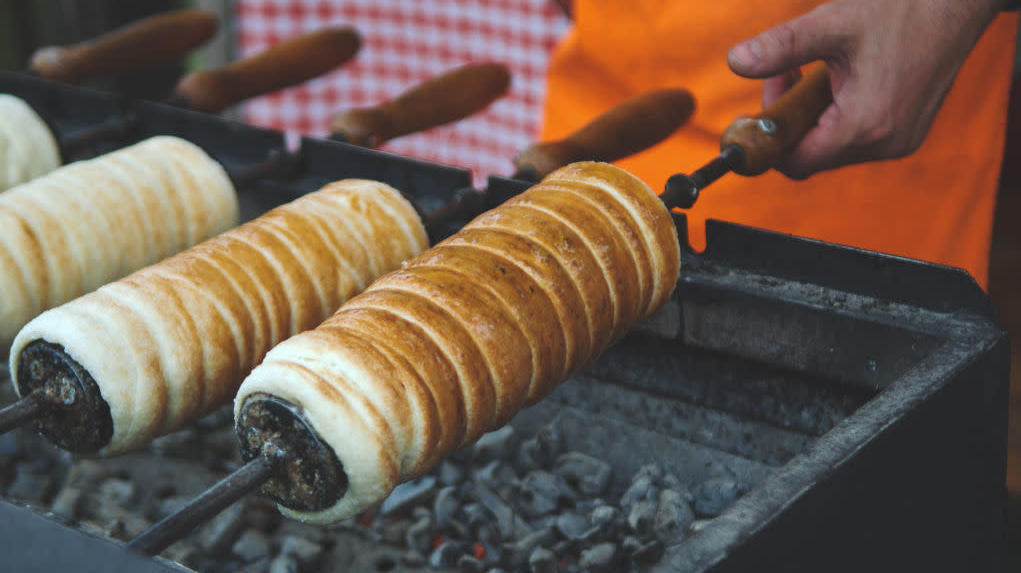Chimney Cakes Are The Best Hungarian Export Since Paprika
My first night in Budapest, I ambled into Karavan, a lively street food court in Pest's hip Jewish Quarter. It was a muggy summer evening, but one stall glowed from a bed of charcoal. Behind, a man wound a long dough rope around a wooden spindle about the size of a rolling pin. Swiveling the spindle as he went, he kept wrapping it until it was mummified in a loose, doughy spiral. Then he rolled it on the counter, nudging the ribbons of the spiral to flatten and coalesce. After a quick sugar bath, the coil hovered above the coals, rigging into a rotating mechanism. With steady revolutions, it baked like a rotisserie pig, bronzing into a honeyed glaze.
After it baked and slipped off the spindle, it was hollow and resembled a pastry telephoto lens. A chimney cake was born!
It's a spit-roasted dessert, a yeasty carb tornado. Tugging on one end makes it unwind like a slinky. I'm not the only enchanted onlooker, either: Anyone who's visited Budapest has likely encountered chimney cake, or kürtőskalács in Hungarian. ("Kürtő" means "stovepipe.") This street food is common in tourist areas, and while its ingredients are simple, it has an Instagrammable flamboyance. Add-ons include nuts, coconut, chili and cocoa, Nutella, sprinkles, fruit, and even Fruity Pebbles cereal. Kürtős Legenda, which I visited, offers a rainbow "unicorn" option. Many kürtőskalács vendors also offer ice cream filling. This isn't a Hungarian tradition. Still, it's an effective tourist tractor beam.
Kürtőskalács is a countryside delicacy, allegedly one of Hungary's oldest pastries. There's a movement (albeit a contested one) to certify kürtőskalács in the European Union as a protected regional product. There are different versions around Central Europe. In Prague, for instance, vendors sell a version called trdelník.
Chimney cakes have long been part of Hungarian cuisine but have recently seen a surge in popularity, says Gábor Bánfalvi of tour guide companies Taste Hungary and Tasting Table Budapest. "It is made in all kinds of places on the streets of Budapest. You find it at pools, markets, and shopping malls all over the country," Bánfalvi explains. It wasn't always this way. As Budapest has become more of a tourist destination since the fall of communism, the ubiquity of chimney cakes has risen in kind. "As a child growing up in the '80s in Hungary, I only had it once in my childhood and our family never made it," Bánfalvi recalls. "So it was always a specialty for me too, ever since it came back. It was always something exotic, almost."
Chimney cakes originated with the Székelys, a Hungarian minority group living in Transylvania, a region that was once within the Kingdom of Hungary but is now part of Romania. During communism, there were restrictions on movement of people and traditions between Romania and Hungary. Bánfalvi muses that the lifting of these restrictions has contributed to the increased visibility of kürtőskalács.

Bánfalvi notes that Hungarians have a sweet tooth, as evidenced by a strong national dessert repertoire including dobos torte (a multi-layered chocolate and caramel cake), Rákóczi túrós (sweet cheese, pastry, and meringue), and flódni (containing apples, walnuts, and poppyseeds). So chimney cakes weren't a hard sell. His children love it. Bánfalvi says many make them at home on the grill in the spring and summer. "I never make them, though. I tried it once and it turned into a disaster with all the dough falling into the fire. So, I'll stick to buying them from people who know what they are doing."
Finding those in the know can be hard, according to avid fans. Budapest-based freelance food writer Dorottya Czuk says it's a real treat to find a good chimney cake. "The trick is the balance between the outside sugar, nuts, etc., and the inside dough," she says. "You can find a cheap but not so bad version at the metro stations and on bigger streets." These cost about $1. More expensive ones will still only run you around $3—find these "at fancier places and at special markets and fairs and stores," says Czuk. Her favorite is at Molnár's Kürtőskalács, near the Danube in Pest.
For Budapest native Andrea Völgyes, kürtőskalács are not everyday fare, nor even tethered to specific events. "I would not say I associate it with a special occasion necessarily," says Völgyes. "It is not like a birthday cake or a traditional Christmas cookie, and definitely not the kind of dessert I would imagine myself eating in a café." Her family associates it with the experiences that draw 30 million tourists to Budapest annually: "The zoo, the Kindertrain in the Buda mountains, visiting a market (especially the Christmas market) or festivals." Her description calls to mind most Americans' relationship to funnel cake. "I cannot actually recall a time when I've eaten one alone," she says.
There's mounting evidence this countryside symbol has officially made it as a go-to crowd-pleaser. There's now an annual festival devoted to chimney cakes, with gluten-free, lactose-free, and "healthy" options alongside the classic version. And they're beginning to pop up around the United States more, too. My advice: If you find one, eat it—even if you're alone.
